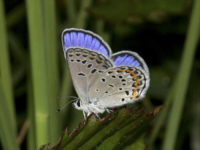Visible landscape changes in the Albany Pine Bush Preserve:
improving wildlife habitat and reducing wildfire risk
ALBANY, NY- Travelers in and around the area of the I-87 and I-90 interchange may notice a significant change happening in the nearby Albany Pine Bush Preserve. The Albany Pine Bush Preserve Commission is contracting tree thinning that will be completed during the fall and winter of 2016 on 91 acres in the Rapp Barrens area (Trailhead # 2) of the preserve. This tree thinning is being completed during the winter months because winter habitat restoration minimizes disruption to wildlife, avoiding the breeding season for species that inhabit the preserve.
“Historically the Pine Bush was an open landscape of grasses, shrubs, wildflowers and scattered pitch pine trees. Due to wildfire suppression and historical agricultural activities, the Pine Bush in some regions of the preserve no longer resembles the unique landscape it once was. To restore this habitat the Albany Pine Bush Preserve Commission will be thinning crowded pitch pine and oak trees along with some other tree species. Non-native trees like black locust will also be removed. This will allow other important pine barrens plants and animals to flourish. The thinning will also help reduce the potential for tree-top or “crown” fires in this sandy, dry, fire dependent environment,” said Albany Pine Bush Preserve Stewardship Director, Joel Hecht. 
President Christopher Hawver added, “With fewer than 20 places like the Pine Bush on Earth, this project will improve habitat for rare wildlife while preserving the barrens for future generations to enjoy. Some of the wildlife species that will benefit from this habitat restoration include birds like the prairie warbler and eastern towhee, other animals such as the hognose snake, spadefoot toad and federally-endangered Karner blue butterfly along with flowers like wild blue lupine.”
